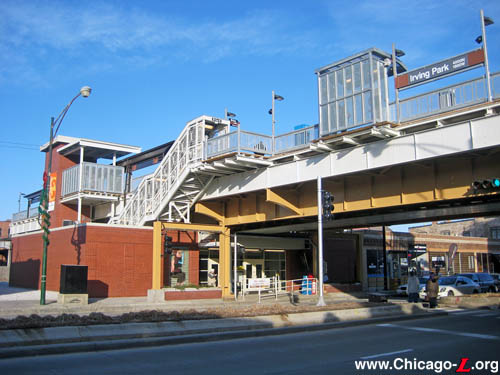
The exterior of the
renovated Irving Park station is seen looking northeast on
January 2, 2009, about a month after the station reopened. The stairways above the station house are a prominent feature of the facility's
street elevation. For a larger view, click here. (Photo by Graham Garfield) |
Irving Park
(4000N/1800W)
Irving Park Road and
Ravenswood Avenue, North Center
Service
Notes:

|
Brown Line: Ravenswood |

|
Accessible Station |
Quick Facts:
Address: 1818 W. Irving
Park Road
Established: May 18, 1907
Original Line: Northwestern Elevated Railroad, Ravenswood
branch
Previous Names: none
|
Skip-Stop Type:
|

|
Station
|
Rebuilt: 2007-08
Status: In Use
History:
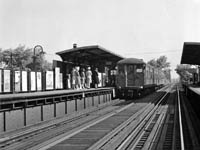
A southbound 4-car
Ravenswood-Englewood-Normal Park train of 4000-series "Baldies" slows to stop at Irving Park on the Ravenswood
branch in the 1940s. For a larger view, click here. (Photo from the CTA Collection) |
Irving Park opened with the initial construction of the Ravenswood branch of the Northwestern Elevated, which was placed into service May 18, 1907. The station was designed in 1905-06 by the Northwestern Elevated's Engineering Office and overseen by Chief Engineer C.M. Mock and Consulting Engineer Charles Weston. The station was built by the Angus Brothers construction company.
The station house measured approximately 25 feet by 25 feet -- a modest size and scale, relating to its role as a modest neighborhood station -- and, when viewed in plan layout, was shaped like a bow-tie. Passengers entered through the front doors and could exit through the building as well, but ancillary exits were also available along the sides of the building's exterior. The building narrowed in the middle to provide space for an exit-only rotogate on each side of the exterior, which passengers could exit through without entering the building. The inclusion of such egress was a result of experience with earlier stations, at which circulation could become congested when passengers tried to enter and exit through the same confined space simultaneously. In later years, the west rotogate was removed and that side passage closed. The east exit rotogate and side passage remained in use until the station was demolished and rebuilt.
The building's exterior was constructed of dark red brick and had a fairly simple design. The foundation was built of stone and concrete. The exterior walls were largely unadorned, except for simple ornamentation around the cornice, belt rail, and in the hood over the front entrance, all of which were executed in the same brick as the rest of the exterior. The doors originally had multi-pane windows.
The interior of the station was similarly modest. The interior walls were clad in glazed brick and had paving brick flooring. A large, bracketed, heavy wood beam ran across the width of the interior in the center, relating a Craftsman influence to the simple design. As built, there were two open areas on either side of the doors at the front for circulation and concessions. The interior then narrowed into the fare control array (due to the aforementioned rotogates along the exterior), which originally consisted of an agent's booth in the center flanked by turnstiles on one side and a heating stove on the other. The original ticket agent's booth was removed in the mid-1990s when the electronic farecard turnstiles were installed, replaced by a new booth on the west wall.
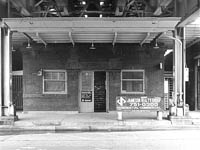
The Irving Park station headhouse is seen looking north in 1986. Save for some modifications to the window panes and the addition of a few signs and lights, the building has been little changed since it was built 80 years before. For a larger view, click here. (CTA photo, Graham Garfield Collection) |
After exiting through the station house's rear doors, passengers walked down an enclosed passageway to access the stairs to the platforms. The passageway featured full-height grillework consisting of bars arranged in a geometric Craftsman pattern punctuated by ornamental cast iron rosettes and an arched galvanized iron roof. Originally, there was a full-height grille down the center of the passageway, meaning passengers had to exit through a specific rear door to access their desired platform, or they would have to reenter the station house to switch to the other side. All of the center panels were later removed to allow access to either platform from the passageway except for one panel nearest to the station house rear elevation. The decorative grillework was carried up the stairways to the platforms.
Irving Park featured dual side platforms, constructed of a wood deck on a steel frame. The platforms featured canopies in the center, covering the stairs from street-level. The canopies, which were typical of the 1907 Ravenswood branch stations, featured a gently arched roof with curved support columns and latticed framing. The platform railings consisted of cast iron posts supporting thin metal bars and ornamental sunflower rosettes in a geometric design alternating with flat panels, topped with an oak handrail. The canopy design would be reused first on the Chicago & Oak Park Elevated (also owned by Charles Yerkes) before becoming the standard for the "L" under the Chicago Elevated Railroads and Chicago Rapid Transit. The railing design was also reused elsewhere on the system, most notably at Clinton/Lake where it was duplicated almost exactly.
Irving Park became an "AB" station under the skip-stop express system instituted on August 1, 1949. The station reverted to an all-stop when A/B service was discontinued in 1995.
A concession was installed in the west bay of the unpaid area during the CTA era. It featured a gray rolling steel grille that enclosed the space when it was closed or not rented.
Irving Park station retained some of its original material until it was renovated in 2007-08. The station retained its original station house and canopies, but unlike most other Ravenswood branch stations very little of the original railings at platform level remained. At some point, the platform railings were replaced with simple, angle-metal railings. The platform also utilized bus shelters as windbreaks in later years.
Brown
Line Capacity Expansion Project
By 2004, ridership had exploded on the Brown
Line -- an 79% increase since 1979 and a 27% increase since 1998
-- such that during peak periods many trains were at crush-loaded,
resulting in commuters left standing on platforms unable to board the
loaded trains, sometimes waiting as one or two trains passed before
they were physically able to board. The problem in large part was
that all Brown Line stations could only accommodate six-car trains
(with the exception of Merchandise
Mart, Chicago, Fullerton and Belmont, which could already hold
eight-car trains), which, along with the limitations of the cab
signal system, limited the line's capacity.
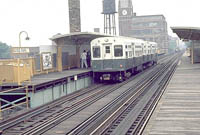
A 2-car Ravenswood All-Stop
of 6000s stops at Irving Park on May 29, 1975. Note the unusual black
and white station name sign on the left. This is one of the
few station name signs from the 1950s/60s that was installed
outside of the Congress and west Lake Lines. For a larger
view, click here. (Photo by Ed McKernen, Collection
of Joe Testagrose) |
As a result, the CTA decided
to plan for the Brown
Line Capacity Expansion Project, the largest capital improvement
project undertaken by the CTA at the time (surpassing even the Douglas
Renovation Project, which was the largest up to that point). The
main objectives of the Brown Line Capacity Expansion Project are to
expand the line's overall ridership capacity by lengthening station
platforms to accommodate eight rather than six-car trains,
rehabilitate rail infrastructure and stations, provide for station
enhancements to meet the accessibility requirements of the Americans
with Disabilities Act (ADA), and upgrade or replace traction power,
signal and communication equipment. By far, the largest part of the Brown Line
Capacity Expansion Project was the station renovations. Of the
Brown Line's 19 stations, only one (Merchandise
Mart) was not touched at all due to its modern construction
(1988) and ability to berth eight-car trains.
On April 13, 2004, the CTA announced that it had officially received a Full Funding Grant
Agreement (FFGA) from the Federal Transit Administration (FTA).
However, in May 2004, CTA received construction bids for the project that substantially
exceeded the budget. As such, the Chicago Transit Board voted on June
9, 2004 to reorganize the project into several discrete pieces to
help attract more competitive construction bids. Station renovation
work was modified and grouped into five separate packages according
to location to help reduce the overall cost of station construction.
Damen station was grouped with Montrose, Irving Park, and Addison in a bid package, all of which were designed by the same consultant, Earth Tech,
Inc. Station designs were also revised to reduce costs. Most
changes concentrated on non-customer areas such as reducing the size
of janitor closets, employee restrooms, electrical rooms and
communication rooms. Other areas that were studied for cost reduction
were standardizing common station elements, the use of less expensive
materials, canopy designs and coverage, and temporary station
closures to provide contractors better access to the sites.
The Damen/Montrose/Irving
Park/Addison contract was the
fourth of the reorganized station packages to be bid out. At the July
20, 2006 board meeting, a $58 million contract for the renovation of
these stations was awarded to James
McHugh Construction.
Following contract approval, the construction contractor prepared and submitted a construction plan to CTA for approval. CTA held a community meeting to provide further construction details and timelines for the work.
The project's Full Funding Grant Agreement with the federal government required that the CTA complete the project by the end of 2009.
Station Design
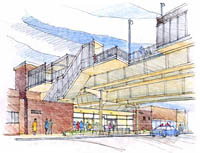
Artist's rendering of the
design for the renovated Irving Park station. A new masonry
station house with a glass front facade replaced the
1907 entrance. Brown Line-standard railings and lights are
visible at platform level above. For a larger view, click here. (Image provided courtesy of
the CTA) |
The new station house is located on the north side of
Irving Park Road, the same side of the street as the original 1907 station
house. The one-story station house, whose footprint measures 74 feet wide by 50 feet deep, is clad in glazed brick on the front and first few feet of the side elevations, and concrete masonry units (CMUs, or "cinder block") on the rest of the sides and rear, with pre-finished galvanized flashing along the top. The exterior walls are solid masonry, with no windows, except for a glandularly storefront in the middle of the front elevation. The brickwork has no variance in color and little ornamentation, save for some sections of brickwork that project slightly to form shallow bays in the wall, and tile artwork to the left of the storefront. The storefront, which takes up roughly the middle third of the front elevation, consists of two sets of double doors frames by glass sidelights and transoms, divided into rectangular panels by white aluminium mullions. A shallow cantilevered canopy
covers the front elevation.
The dual elevator towers are clad in
the same glazed brick as the station house and are topped with a white metal roof but are located the rear of the station house, set bad from the sidewalk about 40 feet. Unlike most stations, whose stairs to their
platforms are largely hidden behind their station houses, Irving Park's
are to the sides and project toward the street rather than away from
it as they ascend upward. As a
result, the stairways are a dominant feature of the station facility
when viewed from the street. The stairways to the platforms are
enclosed in a white-painted steel grille system of thin bars
punctuated by ornamental sunflower rosettes divided by a heavy
tubular steel framework. Although the design of the grilles are meant
to evoke the original station's railings and stairway grilles, they
are new construction. The rosettes, however, are reused from the
original facility.
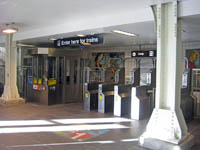
The interior of the
new Irving Park station, with its Brown Line-standard
CA booth, white tile walls, and granite floors, is seen looking northwest
in the unpaid area on January 2, 2009. The original 1907 elevated structure columns pierce the interior of the station house and are a prominent element. For a larger view, click here. (Photo by Graham Garfield) |
The interior has a largely open though compact plan. A Customer Assistant booth
is located in the middle of the interior, slightly west of center, with a row of turnstiles to
the east and standard stainless steel fencing separating the
unpaid and paid areas. The farecard vending machines are located on
the west wall between the front doors and the CA booth. The walls are clad in white
square tiles and the ceiling is made of white metal panels. The floor is gray granite tiles. The new stainless steel CA booth, standard for the new Brown Line stations, features stainless steel lower panels and roof and glass panels around the sides for a high level of visibility. The space is punctuated by a set of steel elevated structure columns in the
middle of the interior, in front of the turnstiles and CA booth.
The dual platforms were renovated with new decking, railings,
lighting, signage, and other fixtures. The existing original canopies
were retained and refurbished, stripped of decades of paint,
repainted dark brown, and topped with new corrugated metal arched
roofs. The new railings are a standard design for the rebuilt Brown Line elevated
stations, with thick tubular top and bottom horizontal members with
rectangular panels with a grid pattern cut out. The railings and
light poles, as well as the other new metalwork, are hot-dipped
galvanized steel. The light poles are integrated into the railing
posts. The platforms are finished with windbreaks integrated into the
railing system with the glass panels protected by metal grilles
matching the railings. New benches with sandboxes integrated into
them dot the platform, posts with projecting horizontal arms for A/V
signs (to be installed later) are suspended over the platforms, and
Transit Information panels are posted near the elevators.
Auxiliary exits are provided to the south side of Irving Park Road, across from the main entrance, to allow for more egress capacity and better connections to eastbound buses. Stairs from each platform lead to a common landing underneath the elevated structure, all enclosed in white-painted steel grillework of thin bars decorated with ornamental sunflower rosettes divided by a heavy tubular steel framework. Stainless steel exit rotogates at platform-level control access from the paid area.
Other improvements included new signage; electrical, communications, and HVAC equipment; new customer heaters on the platforms; and a new public announcement system. Low brick-faced planters line the curbline in front of the station house and auxiliary exit. Irving Park station is unusual in also having a signalized crosswalk across Irving Park Road, covered by a canopy under the elevated structure. This is due to the four-lane width of the street and heavy level of bus-rail transfers that occur at the station.
CTA partnered with the City
of Chicago's Department of Cultural Affairs to install public art at all of the 18 stations included in the Brown Line project. The Irving Park station features tile mosaics created by Juan Carlos Macias. The mosaics, which are located inside and on the front of the station house, depict customers riding public transportation.
Station Renovation Work
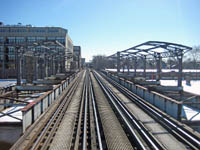
The Irving Park platforms are undergoing renovation in this February 16, 2008 view looking south. All of the old decking, railings, joists and other elements have been stripped, leaving just the canopy frame and steel stringers to undergo refurbishment for reuse in the renovated station. For a larger view, click here. (Photo by Graham Garfield) |
Irving Park station closed at 4am, Monday, December 3, 2007 for renovation. The next station south, Addison, reopened at the same time upon the completion of its renovation, while the next station north, Montrose, had reopened a week earlier following its renovation. The station temporarily closed for a little over a year while construction crews worked to upgrade and extend platforms, rebuild the station house and make the station accessible to customers with disabilities. Consistent with the CTA's pledge that no two consecutive stations would be closed at the same time on weekdays, the adjacent stations -- Addison and Montrose -- remained open during Irving Park's temporary closure so customers may continue to use it to access Brown Line service. In addition to the neighboring stations, alternate service was also available from several area bus routes.
The demolition of the old station house took place in January 2008, with the platform demolition starting at the same time and continuing into February. Lead abetment of the remaining platform steel and the elevated structure columns and stringers took place during January and February as well. The foundations of many of the elevated structure columns required replacement, and this week took place over several months between January and July 2008.
A number of commercial buildings adjacent to the old station had to be purchased and demolished to accommodate the larger footprint of the new facility. Regina's Restaurant, to the west of the old station house, and building housing a Cingular Wireless store to the east, were demolished in March and April 2008, respectively. The Noon Hour Grill, to the west of the elevated structure on the south side of Irving Park Road, was also demolished in April to make room for the auxiliary exit stairs from the inbound platform.
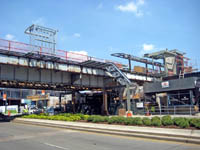
While work on the new station house continues below, installation of new stairs, railings, and other fittings continues above at track level, seen looking southeast on July 17, 2008. For a larger view, click here. (Photo by Graham Garfield) |
Structural steel preparations for the station began in late February 2008, with erection of steel for the platform stringers and joists being undertaken from early March through late June. Foundations for the station house were set in May. The structural steel frames for the elevator towers were largely pre-assembled off-site and brought to the site by truck. They were lifted into place at the station on May 22, 2008.
Erection of the station house's structural steel began in early Summer 2008, with masonry installation occurring in June and July. Construction of the station house, including the installation of structures and systems, continued into August. Work on the elevators, including masonry walls and installation of equipment, was performed during July and August. Meanwhile, work was underway simultaneously at the platform level as well. Wood platform decking was installed throughout summer, from June into August. The galvanized steel platform posts, railings, light poles, and windbreaks were installed during July. The platform lighting and speakers were installed in August.
By late summer, the remaining major elements of the new facility were falling into place. Contractor crews spent autumn finishing the details of the new facility. Work inside the station continued, with installation of the Customer Assistant's booth and other fixtures. Raised concrete planters with brick facing were installed along the curbline outside the main station house and outside auxiliary exit across from the station house. Other items installed during this period also included a compass rose on the sidewalk in front of the station entrance, bike racks at street level at the bottom of the auxiliary exit stairs, and new signage throughout the station facility. Landscaping and sidewalk repairs around the station were also completed. Fare equipment was installed inside the station house on December 2.
On Saturday, December 6, 2008, Mayor Richard M. Daley joined CTA President Ron Huberman and 47th Ward Alderman Gene Schulter at a ceremony to commemorate the re-opening of the Irving Park Brown Line station.
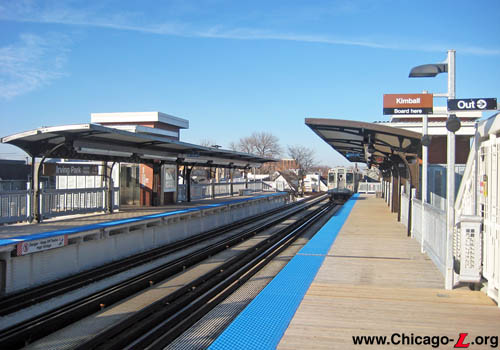
The platforms at Irving Park station are seen looking north on January 2, 2009. The canopies are original 1907-vintage construction and were restored in the station renovation. The
galvanized steel railings and light poles are standard for the renovated Brown Line stations. For a larger view, click here. (Photo by Graham Garfield) |
Old Irving Park (1907-2007) | New Irving Park (2007-present)
Old Irving Park station (1907-2007)

|
irvingpark01.jpg
(130k)
Pullman streetcar 1031, running west on Irving
Park Road, discharges passengers at the Irving Park
Ravenswood "L" station. Note the original platform railings and light fixtures up above, as well as the somewhat unusual sign over the street giving the name of the station as well as the name of the local neighborhood. Also note how the street as been widened, resulting in the elevated structure columns landing in the street instead of at the curbline. (Photo from the
Barney Neuberger Collection) |
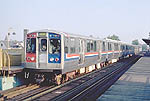
|
cta2407.jpg
(112k)
Car 2407, still relatively new just a couple years after its delivery to the CTA, leads an eight-car Ravenswood "A" train stopping at
Irving Park in August 1978. (Collection of
Joe Testagrose)
|
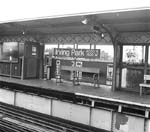 |
irvingpark04.jpg (107k)
This 1986 view of the inbound platform at Irving Park shows how graffiti and vandalism, as well as general issues of maintenance and aging infrastructure, were issues for the CTA in general and the Ravenswood Line in particular during this period Still, the station retains much of its original fabric and character at this point. (CTA Photo, from the Graham Garfield Collection) |
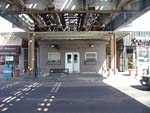 |
irvingpark05.jpg (215k)
An exterior view of Irving Park station, looking north on October 9, 2002. Irving Park station was still well intact architecturally at this point, though its multi-pane windows and doors had all been changed out to more easily-maintained single-pane fixtures, and the brick exterior has been painted light brown. The station is typical of the 1906-07 Ravenswood branch stations between Damen and Southport. (Photo by Graham Garfield) |
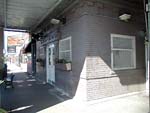 |
irvingpark06.jpg (187k)
Another October 9, 2002 view of the Irving Park station house exterior, looking northwest. This view shows some of the details of the exterior masonry design of the front and side elevations, with its simple ornamentation over the front door, along the cornice, and at the belt rail.(Photo by Graham Garfield) |
 |
irvingpark07.jpg (178k)
The interior of Irving Park station is seen looking north in the unpaid area on October 9, 2002, with its glazed brick walls and Craftsman-inspired wood beams. 20021009. (Photo by Graham Garfield) |
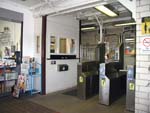 |
irvingpark08.jpg (177k)
This view of the interior of Irving Park station looking northwest on October 9, 2002 shows the new, utilitarian Customer Assistant booth that was built into the west wall when the Automated Fare Collection (AFC) equipment was installed in the 1990s, replacing the original, decorative 1907 ticket agent's booth. The concession stand that was built into the southwest corner of the interior is also visible on the left. (Photo by Graham Garfield) |
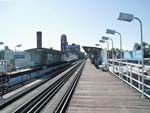 |
irvingpark09.jpg (188k)
Irving Park station's platforms, seen looking south on October 9, 2002, are typical of those on the Ravenswood branch elevated stations. Unlike some other branch stations, Irving Park had some of its original platform materials still intact, including the typical Ravenswood canopies with their curved roofs and elaborate latticework, but lacked many other original features such as its 1907 the platform railings, which were replaced at some point with plain angle iron railings. Some small sections of original railing, with its characteristic sunflower rosettes, remained such as at the railing at the end of the platform at left. (Photo by Graham Garfield) |
New Irving Park station (2008-present)
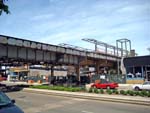 |
irvingpark12.jpg (173k)
The Irving Park station has been completely stripped down, with the station house, platforms, stairs, railings and other infrastructure removed. Only remaining in this May 24, 2008 view are the elements to be reused and refurbished in place -- the platform stringers and the canopy frame. The steel frame for the elevator to the outbound platform has been erected. (Photo by Graham Garfield) |
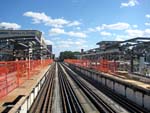 |
irvingpark13.jpg (221)
The Irving Park platforms' renovation is progressing in this eastward view on July 13, 2008. The new wood decking atop the new steel joists is nearly complete. The canopies' refurbishment is almost complete, and the new galvanized steel windbreaks and lighting/railing posts are being installed. The fencing with orange mesh allows work to be performed under protection from passing trains. (Photo by Graham Garfield) |
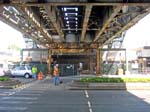 |
irvingpark15.jpg (211k)
The buildout of the station house is advancing on multiple fronts on this July 17, 2008 view looking north, with work underway on steel work, masonry, and utility installation. The new stairs up to the platforms have been assembled and are in place. (Photo by Graham Garfield) |
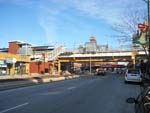 |
irvingpark17.jpg (155k)
This view looking east out Irving Park Road on January 2, 2009 shows the Irving Park station facility from a distance, providing a vantage point to see the complex in its entirety, particularly how the station house, platforms, stairs, and elevator towers relate to one another. (Photo by Graham Garfield) |
 |
irvingpark18.jpg (207k)
One of artist Juan Carlos Macias' tile mosaics at Irving Park station, which depict customers riding public transportation, is displayed on the exterior of the station house, to the west of the front entrance doors. The piece is seen looking north on January 2, 2009. (Photo by Graham Garfield) |
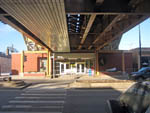 |
irvingpark19.jpg (174k)
The front elevation of the Irving Park station house, with its relatively plain brick facing and aluminum-and-glass storefront entrance, is seen looking north on January 2, 2009. A wreath hung to the right of the entrance doors betrays the fact that it is the holiday season. (Photo by Graham Garfield) |
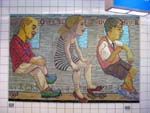 |
irvingpark21.jpg (216k)
The interior of the Irving Park station features two of the tile mosaics created by Juan Carlos Macias, installed at the station through a partnership with the City
of Chicago's Department of Cultural Affairs. The two installations are on the rear (north) wall of the interior, in the paid area; the west mosaic of the pair is seen here on January 2, 2009. (Photo by Graham Garfield) |
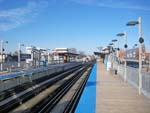 |
irvingpark23.jpg (165k)
Irving Park's rebuilt dual side platforms are seen looking north on January 2, 2009 from over Irving Park Road. Note the covered windbreaks to supplement the original, vintage platform canopies. (Photo by Graham Garfield) |
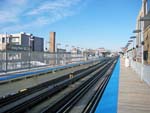 |
irvingpark24.jpg (187k)
The Irving Park station platforms are seen looking north from the far south end of the outbound platform on January 2, 2009. The auxiliary exit stairs down to the south side of Irving Park Avenue are seen in the middle, while the canopies and elevator towers can be seen in the distance. (Photo by Graham Garfield) |
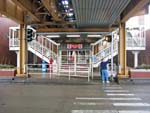 |
irvingpark25.jpg (198k)
The landing of the auxiliary exit stairs from the platforms to the south side of Irving Park Road is seen looking south in March 10, 2010. The stairs descend to mid-level landings, then turn to feed into a central landing area, with railings composed of thin spindles and sunflower rosettes reminiscent of those designed for the original Ravenswood branch elevated stations. Stainless steel rotogates at the tops of the stairs, at platform level, restricting entry. Low brick-faced planters frame the auxiliary exit on both sides. (Photo by Graham Garfield) |
|

|

|





























